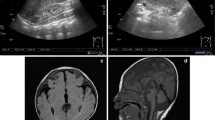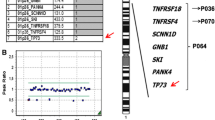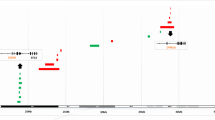Abstract
The chromosomal region critical in Down syndrome has long been analyzed through genotype–phenotype correlation studies using data from many patients with partial trisomy 21. Owing to that, a relatively small region of human chromosome 21 (35.9 ~ 38.0 Mb) has been considered as Down syndrome critical region (DSCR). In this study, microarray-based comparative genomic hybridization analysis identified complex rearrangements of chromosome 21 in a patient manifesting clinical features partially overlapped with that of Down syndrome. Although the patient did not show up-slanting palpebral fissures and single transverse palmar creases, other symptoms were consistent with Down syndrome. Rearrangements were analyzed by whole-genome sequencing using Nanopore long-read sequencing. The analysis revealed that chromosome 21 was fragmented into seven segments and reassembled by six connected points. Among 12 breakpoints, 5 are located within the short region and overlapped with repeated segments. The rearrangement resulted in a maximum gain of five copies, but no region showed loss of genomic copy numbers. Breakpoint-junctions showed no homologous region. Based on these findings, chromoanasynthesis was considered as the mechanism. Although the distal 21q22.13 region was not included in the aberrant regions, some of the genes located on the duplicated regions, SOD1, SON, ITSN1, RCAN1, and RUNX1, were considered as possible candidate genes for clinical features of the patient. We discussed the critical region for Down syndrome, with the literature review.


Similar content being viewed by others
Data availability
The obtained data would be disclosed upon requests.
References
Braddock SR, Carey JC (1994) A new syndrome: congenital thrombocytopenia, Robin sequence, agenesis of the corpus callosum, distinctive facies and developmental delay. Clin Dysmorphol 3(1):75–81
Braddock SR, South ST, Schiffman JD, Longhurst M, Rowe LR, Carey JC (2016) Braddock-Carey syndrome: A 21q22 contiguous gene syndrome encompassing RUNX1. Am J Med Genet A 170(10):2580–2586. https://doi.org/10.1002/ajmg.a.37870
Capkova P, Misovicova N, Vrbicka D (2014) Partial trisomy and tetrasomy of chromosome 21 without Down Syndrome phenotype and short overview of genotype-phenotype correlation. A case report. Biomed Pap Med Fac Univ Palacky Olomouc Czech Repub 158(2):321–325. https://doi.org/10.5507/bp.2013.077
Chang KT, Min KT (2009) Upregulation of three Drosophila homologs of human chromosome 21 genes alters synaptic function: implications for Down syndrome. Proc Natl Acad Sci U S A 106(40):17117–17122. https://doi.org/10.1073/pnas.0904397106
Clark BE, Shooter C, Smith F, Brawand D, Thein SL (2017) Next-generation sequencing as a tool for breakpoint analysis in rearrangements of the globin gene clusters. Int J Lab Hematol 39(Suppl 1):111–120. https://doi.org/10.1111/ijlh.12680
De Coster W, D'Hert S, Schultz DT, Cruts M, Van Broeckhoven C (2018) NanoPack: visualizing and processing long-read sequencing data. Bioinformatics 34(15):2666–2669. https://doi.org/10.1093/bioinformatics/bty149
Ermak G, Morgan TE, Davies KJ (2001) Chronic overexpression of the calcineurin inhibitory gene DSCR1 (Adapt78) is associated with Alzheimer's disease. J Biol Chem 276(42):38787–38794. https://doi.org/10.1074/jbc.M102829200
Hardies K, Cai Y, Jardel C, Jansen AC, Cao M, May P, Djemie T, Hachon Le Camus C, Keymolen K, Deconinck T, Bhambhani V, Long C, Sajan SA, Helbig KL, Suls A, Balling R, Helbig I, De Jonghe P, Depienne C, De Camilli P, Weckhuysen S (2016) Loss of SYNJ1 dual phosphatase activity leads to early onset refractory seizures and progressive neurological decline. Brain 139(Pt 9):2420–2430. https://doi.org/10.1093/brain/aww180
Holland AJ, Cleveland DW (2012) Chromoanagenesis and cancer: mechanisms and consequences of localized, complex chromosomal rearrangements. Nat Med 18(11):1630–1638. https://doi.org/10.1038/nm.2988
Imaizumi T, Yamamoto-Shimojima K, Yamamoto H, Yamamoto T (2020a) Establishment of a simple and rapid method to detect MECP2 duplications using digital polymerase chain reaction. Congenit Anom (Kyoto) 60(1):10–14. https://doi.org/10.1111/cga.12325
Imaizumi T, Yamamoto-Shimojima K, Yanagishita T, Ondo Y, Yamamoto T (2020b) Analyses of breakpoint junctions of complex genomic rearrangements comprising multiple consecutive microdeletions by nanopore sequencing. J Hum Genet in press. https://doi.org/10.1038/s10038-020-0762-6
Jones K (2006) Down syndrome. Smith's recongizable patterns of human malformation, 6th edn. Elsevier saunders, Philadelphia, pp 7–12
Kim JH, Shinde DN, Reijnders MRF, Hauser NS, Belmonte RL, Wilson GR, Bosch DGM, Bubulya PA, Shashi V, Petrovski S, Stone JK, Park EY, Veltman JA, Sinnema M, Stumpel C, Draaisma JM, Nicolai J, Yntema HG, Lindstrom K, de Vries BBA, Jewett T, Santoro SL, Vogt J, Bachman KK, Seeley AH, Krokosky A, Turner C, Rohena L, Hempel M, Kortum F, Lessel D, Neu A, Strom TM, Wieczorek D, Bramswig N, Laccone FA, Behunova J, Rehder H, Gordon CT, Rio M, Romana S, Tang S, El-Khechen D, Cho MT, McWalter K, Douglas G, Baskin B, Begtrup A, Funari T, Schoch K, Stegmann APA, Stevens SJC, Zhang DE, Traver D, Yao X, MacArthur DG, Brunner HG, Mancini GM, Myers RM, Owen LB, Lim ST, Stachura DL, Vissers L, Ahn EYE (2016) De novo mutations in SON disrupt rna splicing of genes essential for brain development and metabolism, causing an intellectual-disability syndrome. Am J Hum Genet 99(3):711–719. https://doi.org/10.1016/j.ajhg.2016.06.029
Kondo Y, Mizuno S, Ohara K, Nakamura T, Yamada K, Yamamori S, Hayakawa C, Ishii T, Yamada Y, Wakamatsu N (2006) Two cases of partial trisomy 21 (pter-q22.1) without the major features of Down syndrome. Am J Med Genet A 140(3):227–232. https://doi.org/10.1002/ajmg.a.31073
Korbel JO, Tirosh-Wagner T, Urban AE, Chen XN, Kasowski M, Dai L, Grubert F, Erdman C, Gao MC, Lange K, Sobel EM, Barlow GM, Aylsworth AS, Carpenter NJ, Clark RD, Cohen MY, Doran E, Falik-Zaccai T, Lewin SO, Lott IT, McGillivray BC, Moeschler JB, Pettenati MJ, Pueschel SM, Rao KW, Shaffer LG, Shohat M, Van Riper AJ, Warburton D, Weissman S, Gerstein MB, Snyder M, Korenberg JR (2009) The genetic architecture of Down syndrome phenotypes revealed by high-resolution analysis of human segmental trisomies. Proc Natl Acad Sci U S A 106(29):12031–12036. https://doi.org/10.1073/pnas.0813248106
Korenberg JR, Kawashima H, Pulst SM, Ikeuchi T, Ogasawara N, Yamamoto K, Schonberg SA, West R, Allen L, Magenis E et al (1990) Molecular definition of a region of chromosome 21 that causes features of the Down syndrome phenotype. Am J Hum Genet 47(2):236–246
Krebs CE, Karkheiran S, Powell JC, Cao M, Makarov V, Darvish H, Di Paolo G, Walker RH, Shahidi GA, Buxbaum JD, De Camilli P, Yue Z, Paisan-Ruiz C (2013) The Sac1 domain of SYNJ1 identified mutated in a family with early-onset progressive Parkinsonism with generalized seizures. Hum Mutat 34(9):1200–1207. https://doi.org/10.1002/humu.22372
Kurabayashi N, Sanada K (2013) Increased dosage of DYRK1A and DSCR1 delays neuronal differentiation in neocortical progenitor cells. Genes Dev 27(24):2708–2721. https://doi.org/10.1101/gad.226381.113
Lyle R, Bena F, Gagos S, Gehrig C, Lopez G, Schinzel A, Lespinasse J, Bottani A, Dahoun S, Taine L, Doco-Fenzy M, Cornillet-Lefebvre P, Pelet A, Lyonnet S, Toutain A, Colleaux L, Horst J, Kennerknecht I, Wakamatsu N, Descartes M, Franklin JC, Florentin-Arar L, Kitsiou S, Ait Yahya-Graison E, Costantine M, Sinet PM, Delabar JM, Antonarakis SE (2009) Genotype-phenotype correlations in Down syndrome identified by array CGH in 30 cases of partial trisomy and partial monosomy chromosome 21. Eur J Hum Genet 17(4):454–466. https://doi.org/10.1038/ejhg.2008.214
Maher CA, Wilson RK (2012) Chromothripsis and human disease: piecing together the shattering process. Cell 148(1–2):29–32. https://doi.org/10.1016/j.cell.2012.01.006
Pellestor F (2019) Chromoanagenesis: cataclysms behind complex chromosomal rearrangements. Mol Cytogenet 12:6. https://doi.org/10.1186/s13039-019-0415-7
Pellestor F, Gatinois V (2018) Chromoanasynthesis: another way for the formation of complex chromosomal abnormalities in human reproduction. Hum Reprod 33(8):1381–1387. https://doi.org/10.1093/humrep/dey231
Plaisancie J, Kleinfinger P, Cances C, Bazin A, Julia S, Trost D, Lohmann L, Vigouroux A (2014) Constitutional chromoanasynthesis: description of a rare chromosomal event in a patient. Eur J Med Genet 57(10):567–570. https://doi.org/10.1016/j.ejmg.2014.07.004
Quadri M, Fang M, Picillo M, Olgiati S, Breedveld GJ, Graafland J, Wu B, Xu F, Erro R, Amboni M, Pappata S, Quarantelli M, Annesi G, Quattrone A, Chien HF, Barbosa ER, Oostra BA, Barone P, Wang J, Bonifati V (2013) Mutation in the SYNJ1 gene associated with autosomal recessive, early-onset Parkinsonism. Hum Mutat 34(9):1208–1215. https://doi.org/10.1002/humu.22373
Schnabel F, Smogavec M, Funke R, Pauli S, Burfeind P, Bartels I (2018) Down syndrome phenotype in a boy with a mosaic microduplication of chromosome 21q22. Mol Cytogenet 11:62. https://doi.org/10.1186/s13039-018-0410-4
Sedlazeck FJ, Rescheneder P, Smolka M, Fang H, Nattestad M, von Haeseler A, Schatz MC (2018) Accurate detection of complex structural variations using single-molecule sequencing. Nat Methods 15(6):461–468. https://doi.org/10.1038/s41592-018-0001-7
Shaw JL, Zhang S, Chang KT (2015) Bidirectional regulation of amyloid precursor protein-induced memory defects by Nebula/DSCR1: a protein upregulated in Alzheimer's disease and down syndrome. J Neurosci 35(32):11374–11383. https://doi.org/10.1523/jneurosci.1163-15.2015
Takenouchi T, Miura K, Uehara T, Mizuno S, Kosaki K (2016) Establishing SON in 21q22.11 as a cause a new syndromic form of intellectual disability: possible contribution to Braddock-Carey syndrome phenotype. Am J Med Genet A 170(10):2587–2590. https://doi.org/10.1002/ajmg.a.37761
Tanaka M, Mino S, Ogura Y, Hayashi T, Sawabe T (2018) Availability of nanopore sequences in the genome taxonomy for vibrionaceae systematics: rumoiensis clade species as a test case. PeerJ 6:e5018. https://doi.org/10.7717/peerj.5018
Tokita MJ, Braxton AA, Shao Y, Lewis AM, Vincent M, Kury S, Besnard T, Isidor B, Latypova X, Bezieau S, Liu P, Motter CS, Melver CW, Robin NH, Infante EM, McGuire M, El-Gharbawy A, Littlejohn RO, McLean SD, Bi W, Bacino CA, Lalani SR, Scott DA, Eng CM, Yang Y, Schaaf CP, Walkiewicz MA (2016) De novo truncating variants in son cause intellectual disability, congenital malformations, and failure to thrive. Am J Hum Genet 99(3):720–727. https://doi.org/10.1016/j.ajhg.2016.06.035
Voronov SV, Frere SG, Giovedi S, Pollina EA, Borel C, Zhang H, Schmidt C, Akeson EC, Wenk MR, Cimasoni L, Arancio O, Davisson MT, Antonarakis SE, Gardiner K, De Camilli P, Di Paolo G (2008) Synaptojanin 1-linked phosphoinositide dyshomeostasis and cognitive deficits in mouse models of Down's syndrome. Proc Natl Acad Sci U S A 105(27):9415–9420. https://doi.org/10.1073/pnas.0803756105
Weisfeld-Adams JD, Tkachuk AK, Maclean KN, Meeks NL, Scott SA (2016) A de novo 2.78-Mb duplication on chromosome 21q22.11 implicates candidate genes in the partial trisomy 21 phenotype. NPJ Genom Med. https://doi.org/10.1038/npjgenmed.2016.3
Yamamoto T, Wilsdon A, Joss S, Isidor B, Erlandsson A, Suri M, Sangu N, Shimada S, Shimojima K, Le Caignec C, Samuelsson L, Stefanova M (2014) An emerging phenotype of Xq22 microdeletions in females with severe intellectual disability, hypotonia and behavioral abnormalities. J Hum Genet 59(6):300–306. https://doi.org/10.1038/jhg.2014.21
Zhu X, Petrovski S, Xie P, Ruzzo EK, Lu YF, McSweeney KM, Ben-Zeev B, Nissenkorn A, Anikster Y, Oz-Levi D, Dhindsa RS, Hitomi Y, Schoch K, Spillmann RC, Heimer G, Marek-Yagel D, Tzadok M, Han Y, Worley G, Goldstein J, Jiang YH, Lancet D, Pras E, Shashi V, McHale D, Need AC, Goldstein DB (2015) Whole-exome sequencing in undiagnosed genetic diseases: interpreting 119 trios. Genet Med 17(10):774–781. https://doi.org/10.1038/gim.2014.191
Acknowledgements
We would like to express our gratitude to the patient and her parents for their cooperation. We thank GeneBay, Inc. (Yokohama, Japan) for supports to analyze whole-genome sequence using Nanopore long-read sequencer.
Funding
This work was supported by the Practical Research Project for Rare/Intractable Diseases (18ek0109270) from the Japan Agency for Medical Research and Development (AMED, TY), JSPS KAKENHI JP18K07803, and Research on Measures for Intractable Diseases from the Ministry of Health Labour and Welfare (TY). We are also thankful for the support from the Initiative on Rare and Undiagnosed Diseases (IRUD) via AMED. This study was partially supported by a Grant-in-Aid for Young Scientists (B) (17K18133) and a Restart Postdoctoral Fellowship (17J40108) from the Japan Society for the Promotion of Science (JSPS) for KY. The data obtained in this study are available on request due to privacy/ethical restrictions.
Author information
Authors and Affiliations
Corresponding author
Ethics declarations
Conflicts of interest
All authors state that there is no conflict of interest.
Additional information
Publisher's Note
Springer Nature remains neutral with regard to jurisdictional claims in published maps and institutional affiliations.
Electronic supplementary material
Below is the link to the electronic supplementary material.
Rights and permissions
About this article
Cite this article
Imaizumi, T., Yamamoto-Shimojima, K., Yanagishita, T. et al. Complex chromosomal rearrangements of human chromosome 21 in a patient manifesting clinical features partially overlapped with that of Down syndrome. Hum Genet 139, 1555–1563 (2020). https://doi.org/10.1007/s00439-020-02196-6
Received:
Accepted:
Published:
Issue Date:
DOI: https://doi.org/10.1007/s00439-020-02196-6




